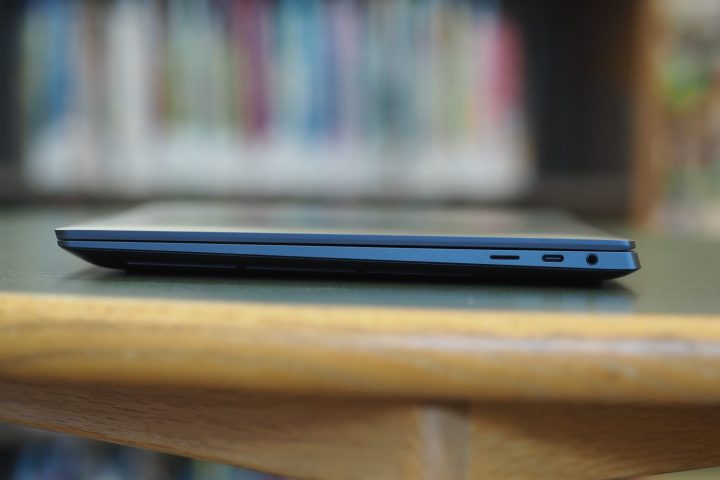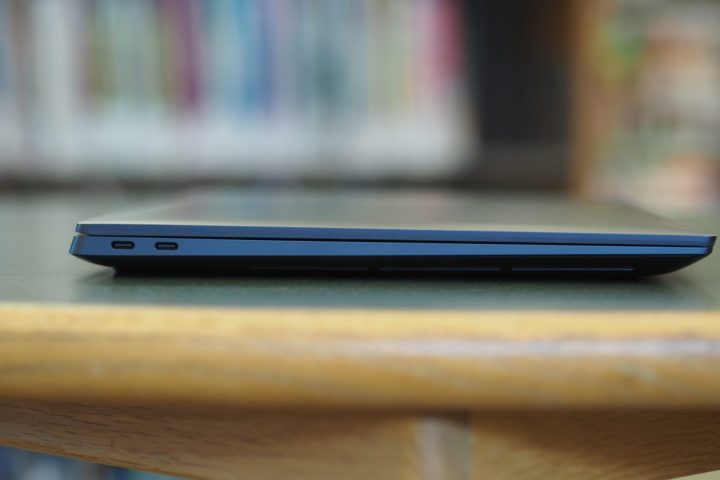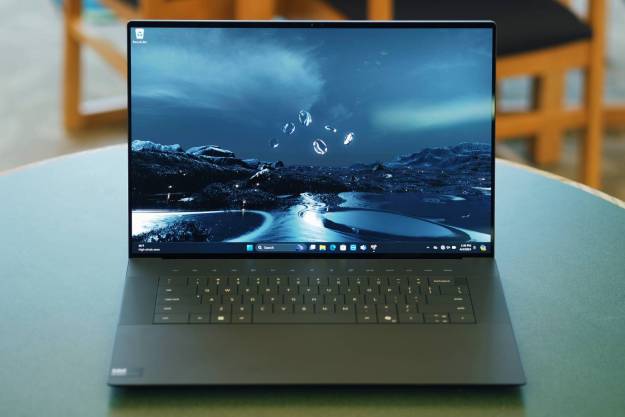
- Attractive, ultramodern aesthetic
- Good keyboard and haptic touchpad
- Strong productivity and creative performance
- Decent 1440p gaming
- A very nice OLED display
- Pleasing audio
- Too expensive
- LED touch function keys are a bust
- Battery life can't keep up
Few laptops have what it truly takes to take on the MacBook Pro. The Dell XPS 16 claims to be one of them, however, and seems to have the credentials to back it up.
This laptop attempts to accomplish this in two ambitious ways. One, by offering a suitable amount of performance to counter the M3 Max MacBook Pro in the form of up to an RTX 4070 GPU. Second, the XPS 16 strives to outdo the MacBook Pro in its sleek design and advanced features, wanting to make even the MacBook Pro seem outdated.
So, here’s the question: Does the XPS 16 actually accomplish these goals? In many ways, the answer is yes. It’s a pricey laptop and has a few notable problems, but the XPS 16 is one of the most beautiful and powerful
Specs and configurations
| Dell XPS 16 | |
| Dimensions | 14.1 inches x 9.4 inches x 0.74 inches |
| Weight | 4.7 pounds |
| Processor | Intel Core Ultra 7 155H Intel Core Ultra 7 165H Intel Core Ultra 9 185H |
| Graphics | Intel Arc graphics Nvidia GeForce RTX 4050 (50W) Nvidia GeForce RTX 4060 (50W) Nvidia GeForce RTX 4070 (60W) |
| RAM | 16GB LPDDR5x (6400 MT/s) 32GB LPDDR5x (6400 MT/s, 7467 MT/s RTX 4070) 64GB LPDDR5x (6400 MT/s, 7467 MT/s RTX 4070) |
| Display | 16.3-inch 16:10 FHD+ (1920 x 1200) IPS non-touch, 60Hz 16.3-inch 16:10 4K+ (3840 x 2400) OLED touch, 90Hz |
| Storage | 512GB SSD 1TB SSD 2TB SSD 4TB SSD |
| Touch | Optional |
| Ports | 3 x USB-C with Thunderbolt 4 1 x 3.5mm audio jack 1 x microSD card reader |
| Wireless | Wi-Fi 7 and Bluetooth 5.4 |
| Webcam | 1080p with infrared camera for Windows 11 Hello |
| Operating system | Windows 11 |
| Battery | 99.5 watt-hours |
| Price |
$2,199+ |
Note: Dell lowered its prices and added a Core Ultra 9 option after this review was written. For now, the XPS 16 is a more affordable (but still expensive) laptop. Because Dell’s prices and configurations are subject to change, this review and its conclusions will be updated if these prices persist.
Let’s get this right out of the way: the XPS 16 is an expensive laptop. It starts at $2,199 with an Intel Core Ultra 7 155H chipset, 16GB of
Various upgrades are also quite costly, like the $1,100 RTX 4070 and $950 Core Ultra 9 185H options. An XPS 16 outfitted with the highest-end components costs $4,549 for a Core Ultra 9 185H, 64GB of
Up to a point, that’s in the same range as the MacBook Pro 16, the laptop that poses the greatest competitive threat to the XPS 16. You can spend a lot more on a MacBook Pro 16, but you’ll also get twice the
My XPS 16 review configuration costs $3,399 for a Core Ultra 7, 32GB of
Meanwhile, a roughly equivalent MacBook Pro 16 with an M3 Max chipset, 48GB of
Design
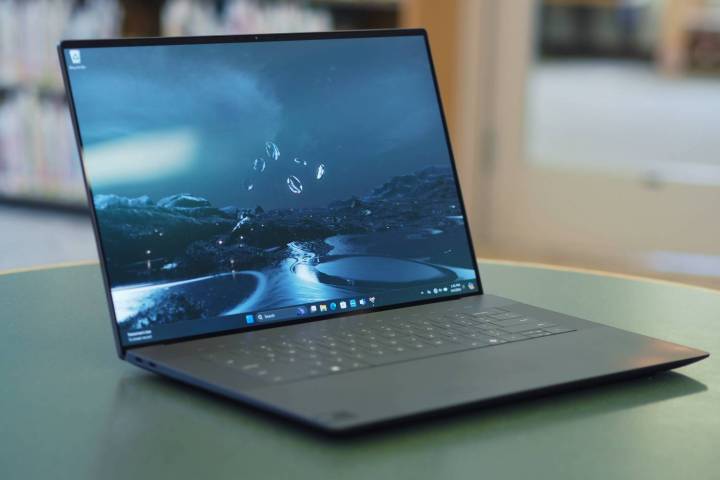
My first reaction to the XPS 16 when I pulled it out of the box was that it’s a very large laptop. But that’s not entirely fair. It has a fractionally larger display than the MacBook Pro 16 but is slightly smaller and roughly the same weight. Importantly, it’s significantly smaller than the XPS 17 it replaces.
That’s thanks to its insanely thin display bezels, within which Dell managed to fit a 1080p webcam with an infrared camera without resorting to the MacBook’s display notch. The XPS 16 is a bit thicker at 0.74 inches versus 0.66 inches, but that’s not so much that you’d notice without putting them side-by-side. The Samsung Galaxy Book4 Ultra is thinner and lighter than both at 0.65 inches and 4.1 pounds.
You expect a laptop this expensive to be built well, and Dell delivers. The XPS 16 is wholly solid, as were the XPS 15 and 17 before it, and it’s as good as the MacBook Pro 16. The MacBook still feels denser, but again, you’d have to hold each side-by-side to notice. The XPS 16’s hinge is just as good, opening smoothly with one hand and holding the display firmly in place.
The quality feel extends to the XPS 16’s aesthetic, which on the outside is roughly the same as its predecessors with more angular sides than the MacBook, suggesting a thinness that isn’t there and making for a streamlined look. My review unit came in the darker Graphite that looks a lot like the MacBook’s Space Black in certain lighting, and the more Dell-traditional Platinum color scheme is also available.
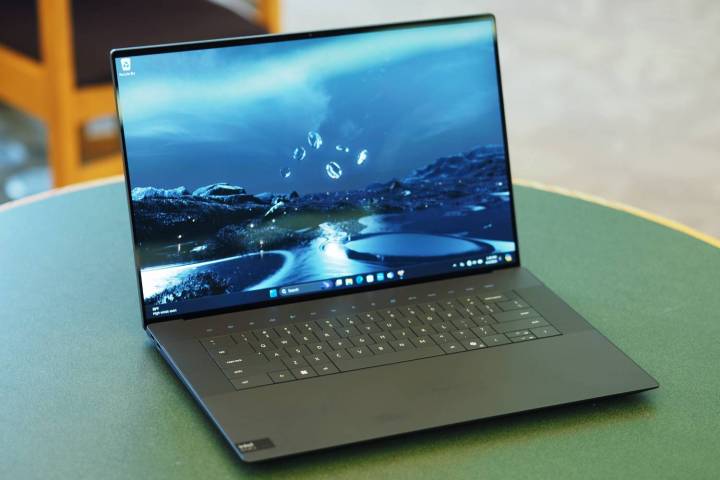
Open the lid, though, and the XPS 16 is a completely different thing. The dominant color is carried forward and highlighted, with an all-glass palm rest that’s unbroken by touchpad lines and flows into the speaker grills that flank a zero-lattice keyboard. The illusion of an unbroken expanse is maintained — until that is, your eyes are drawn to the row of LED touch function keys. These are all ultramodern touches for sure, and when mated with the thin bezels, they make for a laptop that looks as up-to-date as they get.
The question, though, is this: Are they the right touches? And it’s a mixed bag.
As I use the XPS 16, I find the hidden haptic touchpad pretty good despite its being hidden. At least, it’s pretty good when I turn the haptics to their maximum setting. Anything less, and they’re too weak, and the haptic touchpad on the HP Spectre x360 16 is better.
The touchpad is large enough that I never found myself trying to swipe the bare glass, something I experienced on the smaller XPS 14 with a similar design. The touchpad isn’t as good as the Force Touch version on the MacBook Pro 16, which is just as large, more realistic, and features Apple’s exclusive Force Click functionality.
The zero-lattice keyboard took me a little while to get used to. I love Apple’s Magic Keyboard with its large keycaps, tons of key spacing, and light, snappy, and precise switches. The XPS 16’s keyboard also has light, snappy, and precise switches. But, while its keycaps are very large, the complete lack of spacing was uncomfortable at first.
I got faster with it as I was typing this review, but I can’t say I loved the feel in quite the same way. The keyboard has the new Windows Copilot key, but that seems little more than a gimmick at this point.

If the keyboard was a neutral experience, the LED touch function keys were a detriment. Maybe I could account for them with the smallest family member, the XPS 13 Plus (now just the XPS 13), because Dell could argue they fit better or leave more room inside. Or something.
On the XPS 16, they seem silly. I don’t mean to be harsh, but I don’t see the point. They’re not as naturally responsive as physical keys, especially without any haptics to provide feedback, and there’s plenty of room for another row of real keys. Of all the XPS 16’s features, this one boggles my mind. I understand Dell’s desire to create a cohesive XPS lineup, but in this type of laptop, standard keys feel like a no-brainer.
Connectivity
Another knock on the XPS 16 as a member of the new XPS lineup is its limited connectivity. This massive beast of a laptop has the same connectivity as the smallest XPS. Okay, not exactly the same, but you get my point. The XPS 16 has one more
There are no legacy ports, like the MacBook Pro 16’s HDMI connection, and the laptop’s creator target would much rather be able to plug in full-size SD cards than use another dongle.
Again, many of this laptop’s rivals win here. Even worse, maybe, is that the XPS 16 is powered via USB-C, unlike the MacBook with its MagSafe 3 connector. That means one
Wireless connectivity is certainly fully modern. The XPS 16 supports the latest Wi-Fi 7 and Bluetooth 5.4, and while some time will pass before Wi-Fi 7 becomes a widespread standard, the XPS 16 will be ready for it.

The webcam is a 1080p version and provides a good enough image for videoconferencing. The Neural Processing Unit (NPU) in the Meteor Lake chipset helps power Microsoft Studio Effects for background blur, eye contact, and automatic framing. Dell built in its user presence sensing technology to log you in when you come back to the laptop and lock it when you step away.
The infrared camera works well for
Thermals and power
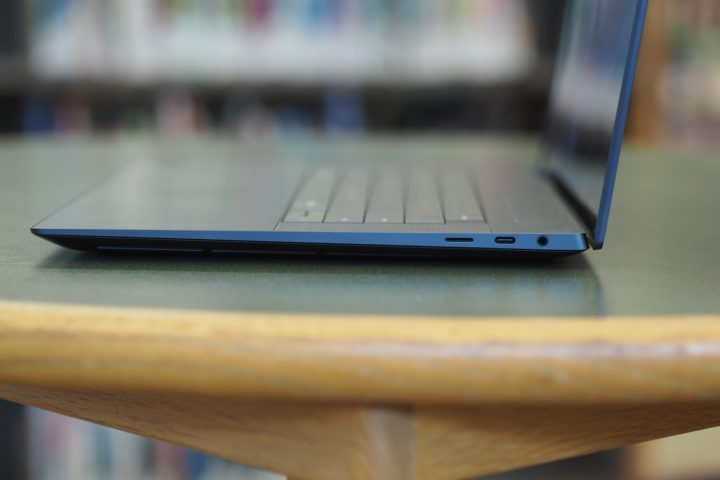
The XPS 16 can be configured with up to a 45-watt Core Ultra 9 185H, a 14-core (six Performance, eight Efficient, two Low Power Efficient), 22-thread CPU running at up to 5.1GHz. I reviewed it with the 28-watt Core Ultra 7 155H, which has the same core count but runs at up to 4.8GHz. I also reviewed the highest-end GPU option, the Nvidia GeForce RTX 4070. The XPS 16 can also be configured with integrated Intel Arc graphics only, the RTX 4050, and the RTX 4060. That’s a step back from the XPS 17’s optional RTX 4080 (however, see below).
In evaluating the XPS 16’s performance, we’ll need to dig into the specs a little. The max thermal envelope for the laptop’s cooling solution is 80 watts, which Dell balances between the CPU and the GPU based on the task. The XPS 16’s RTX 4070 can take up to 60 watts (in performance mode, out of the chip’s maximum 115 watts), while the RTX 4050 and RTX 4060 can take up to 50 watts maximum (the RTX 4060 can also handle up to 115 watts). That raises some questions considering each CPU’s minimum assured power — 20 watts with the Core Ultra 7 and 35 watts with the Core Ultra 9 185H — and maximum Turbo power of 115 watts.
Theoretically, when running entirely CPU-intensive tasks, the CPU can use all 80 watts when using the integrated graphics via Nvidia’s Optimum switching architecture. When running games, the discrete GPU will receive up to the 60-watt maximum with the Core Ultra 7 but likely something less with the Core Ultra 9 (it’s unclear what that CPU’s actual minimum will be in practice). Tasks that blend the CPU and GPU, such as video editing, will therefore see mixed performance. Given its larger power draw, whether the Core Ultra 9 offers much of an advantage is questionable, and an RTX 4080 would be completely wasted.
Compare this to the Alienware m16 R2, which can also be configured with up to the Core Ultra 9 and the RTX 4070 but can handle up to 175 watts. That’s a lot more power to both the CPU and the GPU. However, that gaming laptop is considerably thicker (0.93 inches) and heavier (5.75 pounds). The XPS 16, by contrast, is intended to balance performance with portability.
Performance
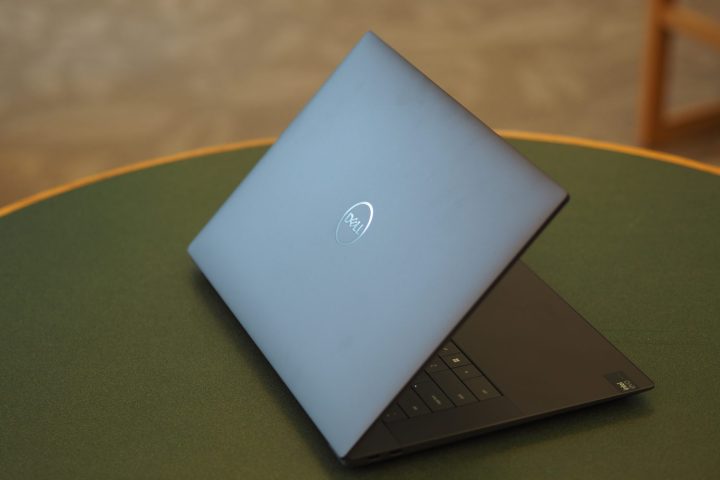
So, how well did it do? It all depends on how you want to use it. And before we dig into that data, I’ll anticipate some likely questions: The XPS 16 never got more than warm on the chassis bottom (105 degrees Fahrenheit max) and remained cool on the keyboard deck where my hands rested. The CPU did get a little toasty (up to 103 degrees C) and throttled more than I’d like. But overall, the heat was well-controlled.
The entirely rear-venting fans (with rear intake and no bottom vents to block) certainly made some noise at full blast, but not more than many other fast
The XPS 16 is primarily intended as a very fast productivity laptop with an expansive display, as well as a more portable workstation for demanding creativity tasks like video editing. In this regard, it does well enough. I ran the Pugetbench Premiere Pro benchmark, which runs in a live version of Premiere Pro and can use a discrete GPU to speed up various tasks. I ran the latest Pugetbench version with Premiere Pro 24.1, which means several of the fast creator workstations in the comparison group were left out.
I included the Alienware m16 R2 because it’s a useful comp, and I wanted to see what the same components could do in a laptop that provides them with a lot more power. I also included results from the MacBook Pro 16 with the fastest M3 Max chipset with 16 CPU cores, 40 GPU cores, and 48GB of unified
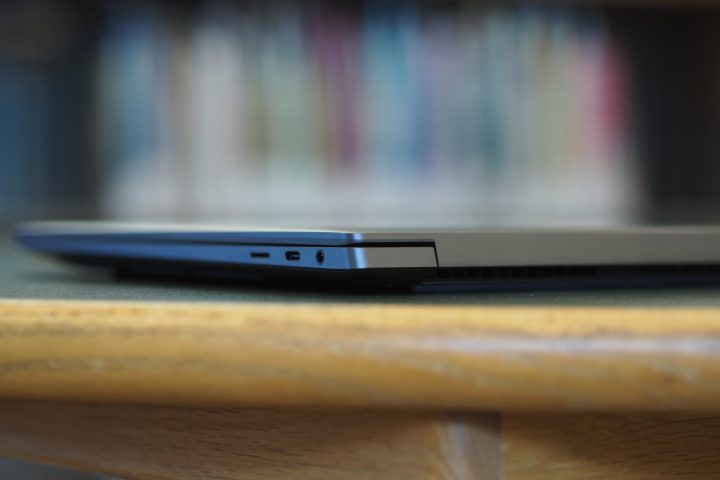
The XPS 16 performed well in the Pugetbench benchmark, rivaling the Alienware. It’s a strong result that promises good performance for creators. It’s also well behind the MacBook Pro 16, which has a ton of GPU cores to throw at things and several CPU optimizations that make short work of various encoding and decoding tasks. The MacBook is the fastest laptop we’ve reviewed in this benchmark, and only the Asus ROG Strix Scar 18 — a very large, very powerful
In the rest of our benchmarks, the XPS 16 was fast but not remarkably so compared to the competition. It wasn’t faster than the XPS 17, a little surprisingly, and while it kept up with the Alienware m16 R2, it fell way behind the MacBook Pro 16. The Cinebench R24 scores were particularly one-sided, with the MacBook Pro 16 and the ROG Strix 18 in a different class entirely. The MacBook’s GPU was about 25% faster than the XPS 16’s RTX 4070, which is around what I would expect.
Overall, the XPS 16 somewhat overcomes its power constraints and gives a credible showing. It’s not the fastest 16-inch laptop by any means, and that’s by design to keep things from melting down. However, if price to performance is considered, the XPS 16 costs a pretty penny. Given its more impressive performance, it’s easy to argue that the MacBook Pro 16 is worth considerably more.
| Geekbench 6 (single/multi) |
Handbrake (seconds) |
Cinebench R24 (single/multi/GPU) |
Pugetbench Premiere Pro |
|
| Dell XPS 16 (Core Ultra 7 155H / RTX 4070) |
Bal: 2,196 / 12,973 Perf: 2,238 / 12,836 |
Bal: 72 Perf: 73 |
Bal: 100 / 838 / 9,721 Perf: 102 / 895 / 10,477 |
Bal: 5,401 Perf: 5,433 |
| Apple MacBook Pro 16 (M3 Max 16/40) |
Bal: 3,083 / 20,653 Perf: 3,119 / 20,865 |
Bal: 55 Perf: N/A |
Bal: 140 / 1,667 / 13,146 | Bal: 8,046 Perf: N/A |
| Alienware m16 R2 (Core Ultra 7 155H / RTX 4070) |
Bal: 2,366 / 12,707 Perf: N/A |
N/A | Bal: 103 / 1,040 / 10,884 | Bal: 5,590 Perf: N/A |
| Asus ROG Strix 18 (Core i9-14900HX / RTX 4090) |
Bal: 2,956 / 17,622 Perf: N/A |
N/A | Bal: 124 / 1,533 / 22,067 | Bal: 7,430 Perf: N/A |
| Asus ProArt Studiobook 16 OLED (Core i9-13980HX / RTX 3000 Ada) |
Bal: 2,312 / 16,034 Perf: 2,312 / 16,075 |
Bal: 50 Perf: 49 |
Bal: 103 / 1,277 / 11,228 Perf: 103 / 1,556 / 11,231 |
N/A |
| Lenovo ThinkPad P1 Gen 6 (Core i7-13800H / RTX 4080) |
Bal: 2,562 / 12,146 Perf: 2,660 / 12,301 |
Bal: 75 Perf: 72 |
N/A | N/A |
| Dell XPS 17 (9730) (Core i7-13700H / RTX 4070) |
Bal: 2,582 / 12,953 Perf: 2,579 / 13,037 |
Bal: 79 Perf: 71 |
N/A | N/A |
| HP Envy 16 2023 (Core i9-13900H / RTX 4060) |
Bal: 1,997 / 12,742 Perf: 1,992 / 12,645 |
Bal: 73 Perf: 75 |
N/A | N/A |
Gaming performance
A natural question is, can the XPS 16 play games? The simple answer is that it can, naturally enough. The RTX 4070 is a capable GPU, even when fed so little power. But thinking of the XPS 16 as a
I ran a couple of gaming benchmarks, and the XPS 16 was a decent performer. It hit 50 frames per second (fps) in Cyberpunk 2077 at 1440p and Ultra quality and with FSR 2.1 set at Quality. The Alienware m16 R2 hit 55 fps. At 1080p and ultra graphics with
In a few other games, the XPS 16 also managed playable frame rates at 1440p and with graphics turned up. Those include Assassin’s Creed Valhalla at 104 fps and ultra-high graphics and Civilization VI at 126 fps at ultra graphics.
Generally speaking, although the XPS 16 I reviewed had a
Battery life
I’m breaking out the battery life results because, as we’ve seen, the MacBook Pro 16 is the XPS 16’s most important competitor. Apple’s Silicon chipsets are incredibly efficient, even as they’re incredibly fast. The MacBook lasted a remarkable 19 hours in our web browsing test and 27 hours in our video looping test. Those aren’t tremendously taxing tests, but these results mean that even with its high-res power-hungry mini-LED display, the MacBook Pro 16 can perform demanding work for something approaching a full day. That’s impressive.
The XPS 16 is … well … less impressive. It has a large 99.5-watt-hour battery but, on my review unit, a very power-hungry high-res OLED display. It managed 5.5 hours in our web browsing test and 5.5 hours in our video looping test.
The former is a decent time for a powerful Windows laptop, while the latter isn’t so great, and they underscore the dramatic difference between Intel and Apple Silicon chipsets. You won’t get much past lunchtime, even running light tasks like web browsing, email, and media consumption. And make sure you carry the power adapter with you if you need to do any creative work on the go.
Display and audio
I reviewed the XPS 16 with its 16.3-inch
Subjectively, the OLED display is very good, with the usual bright, dynamic colors and inky blacks, as well as very sharp text and graphics. My colorimeter agreed, for the most part. The display was bright at 432, and its blacks were perfect with near-infinite contrast. Colors were very good at 100% of sRGB and 100% of DCI-P3, with its one weak point being AdobeRGB coverage of “just” 90%. While that’s still very good, it does fall short of other OLED panels that are typically 95% or higher. Color accuracy was excellent at a DeltaE of 0.59 (1.0 or less is indistinguishable to the human eye).
Everyone will love this display, whether productivity users, media consumers, or creators. The latter might trip over the AdobeRGB number, but that’s as good as the MacBook Pro 16’s display, which comes in at 89%. The MacBook’s color accuracy wasn’t as good, at a Delta-E of 1.22.
However, the MacBook’s display gets incredibly bright at 640 nits in standard dynamic range (SDR) and up to 1,600 nits in high dynamic range (

Audio is provided by four speakers, two upward-firing tweeters and two side-firing woofers. The system is the best yet in an XPS laptop, with tremendous volume, clear mids and highs, and legitimate bass. I had to reduce the volume to around 90% to avoid distortion, but that was still very loud.
Once again, I have to compare the XPS 16 to the MacBook Pro 16, which has a six-speaker system including force-cancelling woofers. The MacBook wins out with distortion-free audio that’s just as loud and with even more bass. Even so, the XPS 16 comes as close as any Windows laptop I’ve reviewed.
A very good laptop, but wait for Dell to lower the price
I’m a fan of the XPS 16, but I’m also aware of its limitations. The GPU is underpowered. The connectivity is limited. And let’s be honest: the LED function keys make an otherwise good keyboard downright frustrating.
However, the laptop performs well enough to meet the needs of its primary target: a creator who wants a reasonably thin and light laptop to carry around. The XPS 16 is attractive and exceedingly well-built, and I found it comfortable to use once I grew accustomed to its idiosyncrasies.
But it’s also very expensive. It’s facing some incredibly stiff competition, such as the MSI Prestige 16 and the Samsung Galaxy Book4 Ultra, both of which cost hundreds less. Even the MacBook Pro 16 is only slightly more expensive when we’re talking about spending over $3,000. And the MacBook Pro 16 beats the XPS 16 soundly in both performance and battery life. If you must buy a Windows laptop, then by all means, add the XPS 16 to your list. Dell tends to lower its prices when its products have been around for a while, though, and once it does, the XPS 16 will be even easier to recommend.

